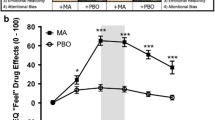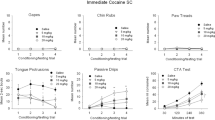Abstract
Eight volunteers maintained on daily methadone participated in a classical conditioning procedure to determine which if any of the elements of narcotic withdrawal could be conditioned. The unconditioned stimulus was the injection of a small dose of naloxone. The unconditioned response was a brief precipitated withdrawal syndrome. The conditioning stimulus was a tone, odor, and injection of saline. Conditioning was successful in the pilot study in 5 of 8 subjects. The conditioned response consisted of tearing, yawning, lacrimation, systolic blood pressure increase, respiratory irregularities and subjective feelings of narcotic withdrawal sickness (nausea, muscle aches, chills). A second group of 8 subjects showed, in addition to the above, evidence of conditioning of heart rate, respiratory rate and skin temperature decrease. These laboratory findings support the clinical reports of a conditioned withdrawal syndrome and suggest ways to improve treatment results by detecting and extinguishing or modifying conditioned responses.
Similar content being viewed by others
References
Goldberg, S. R. and Schuster, C. R.: Conditioned nalorphine-induced abstinence changes: persistence in post-morphine-dependent monkeys.J. Exp. Anal. Behav. 14:33–46, 1970.
O’Brien, C. P., Chaddock, B., Woody, G., and Greenstein, R.: Systematic extinction of narcotic drug use using narcotic antagonists. Proceedings of the Committee on Problems of Drug Dependence, 1974. National Academy of Sciences, Washington, D.C.; pp. 216–222.
O’Brien, C. P., O’Brien, T. J., Mintz, J., and Brady, J. P.: Conditioning of narcotic abstinence symptoms in human subjects.Drug Alcohol Depend. 1:115–124, 1975.
O’Brien, C. P.: Experimental analysis of conditioning factors in human narcotic addiction.Pharmacol. Rev. 27:533–543, 1975.
Teasdale, J.: Conditioned abstinence in narcotic addicts.Int. J. Addict. 8: 273–292, 1973.
Wikler, A.: Recent progress in research on the neurophysiologic basis of morphine addiction.Am. J. Psychiat. 105:329–338, 1948.
Wikler, A.: Conditioning factors in opiate addictions and relapse.In D. M. Wilner and G. G. Kassebaum (Eds.): Narcotics. McGraw-Hill Book Co., 1965; pp. 85–100.
Wikler, A.: Dynamics of drug dependence, implication of a conditioning theory for research and treatment.Arch. Gen. Psychiat. 28:611–616, 1973.
Author information
Authors and Affiliations
Rights and permissions
About this article
Cite this article
O’Brien, C.P., Testa, T., O’Brien, T.J. et al. Conditioning in human opiate addicts. Pav. J. Biol. Sci. 11, 195–202 (1976). https://doi.org/10.1007/BF03000314
Issue Date:
DOI: https://doi.org/10.1007/BF03000314




